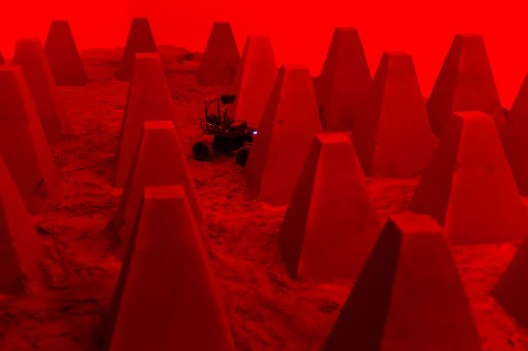Nadim Abbas: “The Last Vehicle”
UCCA (798 Art District, No. 4 Jiuxianqiao Lu Chaoyang District, Beijing, China 100015), Aug 19 – Oct 23, 2016
“The last vehicle” was a complex reflection on future and present scenarios, exploring perception and psychological patterns in which subjects and objects define unexpected relationships via a form of interplay between reality, augmented reality, and virtual reality merged into each other. Amid this scheme, viewers’ reactions are challenged and questioned through alternating sensory and cognitive experiences and stimulations as a fundamental part of the work.
Visiting the two sections of the show, one engaged with different atmospheres: one an alien landscape where the space was dark save for an intense red light illuminating multiple pyramidal forms made of sand inspired by the “Dragon teeth” concrete fortifications of the Second World War. The other was a domestic scene consisting of a bathroom with a sink continuously running water (a smart reference to Marcel Duchamp) and a bunker. There were video cassettes, toilet paper, a screen, and some augmented and virtual reality ocular devices. Sometimes a performer acting as an explorer was sitting there following the footage continuously broadcasted by the drone “vehicle” from which the show got its name and which wandered around the sand installation. Another performer acting like an alien creature with multiple insectoid eyes crawled in the sand and stared viewers or silently interacted with them in small weird movements.
Commenting on the paradox that the image always comes before the object, as in data collection from remote space, and reflecting on the time displacement and discomfort generated by automated forms or exploration and action (like drone activity, in which we already know somebody is dead or somewhere has been destroyed a few minutes before it happens), Abbas seems to suggest that the object and the event are both ungraspable because they have always already been displaced by the image itself, which is the only thing that remains.
Even if these kinds of inquiries and iconography have recently been quite common among artists, the care and subtlety Abbas put into the design of the whole and of each single detail succeeded in making this installation fascinating and hypnotic.
Both environments emanated a strange silence and exercised an invisible conditioning and haunting force; spending time in each of them provided one with a displaced form of intimacy and an interesting psychological state in which the familiar and the alien merged continuously into one another.




